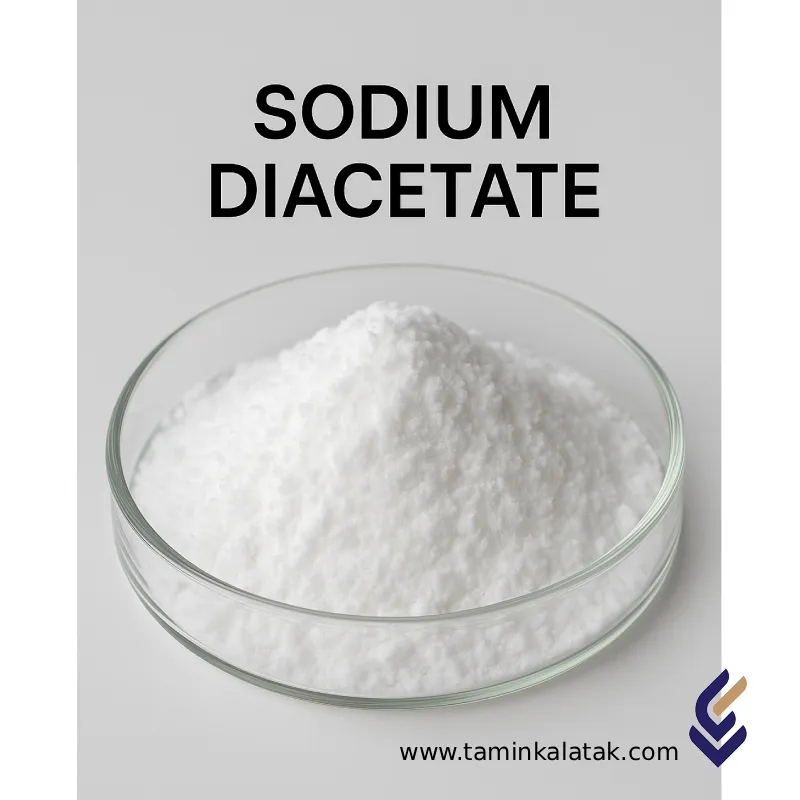Sodium Diacetate
Sodium Diacetate (NaH(C₂H₃O₂)₂) is a double salt composed of sodium acetate and acetic acid, widely recognized as a versatile food additive. Registered under CAS No. 126-96-5, it appears as a white crystalline powder with a mild vinegar-like odor. Sodium diacetate exhibits antimicrobial properties and serves as an acidity regulator, making it highly useful in the food, pharmaceutical, and chemical industries.
Chemical Structure of Sodium Diacetate
-
Chemical formula: NaH(C₂H₃O₂)₂
-
Composition: Formed by the reaction of sodium acetate and acetic acid
-
Functional group: Double salt of acetic acid
-
Appearance: White crystalline solid with a faint acetic acid odor
-
Solubility: Soluble in water and stable under ambient conditions
The structure allows sodium diacetate to act not only as a buffering agent but also as a slow-release source of acetic acid.
Physical and Chemical Properties of Sodium Diacetate
| Property | Description |
|---|---|
| Appearance | White crystalline powder with mild acetic acid odor |
| Melting Point | 150–160 °C |
| Solubility | Freely soluble in water |
| pH (1% aqueous solution) | 4.5 – 5.0 |
| Stability | Stable under cool, dry conditions |
| Taste | Slightly salty with a vinegar-like flavor |
Grades of Sodium Diacetate
1. Food Grade Sodium Diacetate
-
Approved food additive (E262(ii))
-
Functions as an acidity regulator, antimicrobial, and preservative
-
Widely used in bakery, meat, and dairy industries
2. Pharmaceutical Grade Sodium Diacetate
-
Used as an excipient in pharmaceutical formulations
-
Provides antimicrobial protection and pH control in drug manufacturing
3. Industrial Grade Sodium Diacetate
-
Used in chemical processes, animal feed, and odor control
-
Exhibits antifungal and antimicrobial effects in non-food applications
Applications of Sodium Diacetate
1. Food Industry
-
Preservative and Antimicrobial Agent: Prevents mold and bacterial growth in bread, cakes, and baked goods.
-
Acidity Regulator: Controls pH in sauces, dressings, and beverages.
-
Flavor Enhancer: Imparts a mild vinegar-like taste to snacks, chips, and processed foods.
-
Shelf-life Extension: Widely used as food additive E262(ii) to extend product freshness.
2. Pharmaceutical Industry
-
Used in antiseptic formulations and personal care products.
-
Contributes to microbial control in pharmaceutical compositions.
3. Animal Feed
-
Acts as an antimicrobial additive in livestock and poultry feed.
-
Enhances feed safety and prevents spoilage.
4. Chemical Industry
-
Serves as a deodorizing and antifungal agent in various products.
-
Applied in specialized chemical formulations.
Advantages of Sodium Diacetate
✅ High safety for food and pharmaceutical uses (approved by FDA and EFSA)
✅ Multifunctional — applicable across food, pharmaceutical, and industrial sectors
✅ Strong antimicrobial activity against molds and bacteria
✅ Enhances food shelf life and reduces waste
✅ Improves flavor with a mild vinegar profile
Disadvantages of Sodium Diacetate
⚠️ Excessive use can result in an overly strong or unpleasant flavor
⚠️ High concentrations may cause gastric irritation
⚠️ Hygroscopic — readily absorbs moisture in humid environments
Safety and Storage Guidelines
-
Store in airtight, moisture-resistant containers
-
Keep away from direct sunlight, in a cool, dry environment
-
Use protective gloves and goggles in industrial handling
-
Follow approved dosage limits for food applications (E262 standard)
Sodium Diacetate Production Process
-
Step 1 – Sodium Acetate Production:
Reaction of acetic acid with sodium carbonate or sodium hydroxide. -
Step 2 – Addition of Extra Acetic Acid:
Sodium acetate reacts with excess acetic acid to form the double salt (sodium diacetate). -
Step 3 – Cooling and Crystallization:
The resulting solution is cooled, allowing sodium diacetate crystals to form. -
Step 4 – Drying and Packaging:
The dried crystals are processed into a fine white powder and packaged for commercial use.
Technical Specifications of Sodium Diacetate
| Parameter | Approximate Value |
|---|---|
| Chemical Name | Sodium Diacetate |
| Chemical Formula | NaH(C₂H₃O₂)₂ |
| CAS Number | 126-96-5 |
| Appearance | White powder with mild acetic acid odor |
| Melting Point | 150–160 °C |
| Solubility in Water | High |
| Grades | Food, Pharmaceutical, Industrial |
| Food Additive Code | E262(ii) |
Purchasing Sodium Diacetate
To purchase high-quality sodium diacetate and get the best pricing, it’s important to choose a reliable supplier.
Tamin Kala Tak Co., with years of experience in supplying raw materials for the food, pharmaceutical, and chemical industries, offers sodium diacetate in multiple grades.
Contact our experts today for orders and price inquiries.
❓ Frequently Asked Questions Sodium Diacetate
1. What is Sodium Diacetate?
A double salt of sodium acetate and acetic acid, used as a food additive, antimicrobial, and acidity regulator.
2. What’s the difference between Sodium Acetate and Sodium Diacetate?
Sodium acetate is a simple salt of acetic acid, while sodium diacetate contains additional acetic acid, providing stronger antimicrobial properties and a vinegar-like flavor.
3. Is Sodium Diacetate safe for consumption?
Yes. Food-grade sodium diacetate (E262(ii)) is approved by both the FDA and EFSA as safe for use in food.
4. What industries use Sodium Diacetate?
It’s used in food (bakery, meat, snacks), pharmaceutical, animal feed, and chemical industries.
5. How is the price of Sodium Diacetate determined?
Pricing varies based on grade, purity, supplier, and market conditions.
Sodium Diacetate
| Chemical name | Chemical formula | CAS number | Grade | Vapor pressure | Physical appearance | Density (at 20°C) | Melting point | Solubility in water |
|---|---|---|---|---|---|---|---|---|
| Oxalic Acid | C₂H₂O₄ | 144-62-7 | Reagent Grade, ACS Grade, Analytical Grade, Food Grade | Very low; ~0.0013 mmHg at 25°C (for anhydrous form) | White or colorless solid crystals | 1.653 g/cm³ (for anhydrous form) | 101–102 °C (for the dihydrate, C₂H₂O₄·2H₂O) | Very soluble; about 10 g in 100 mL of water at 20°C |







